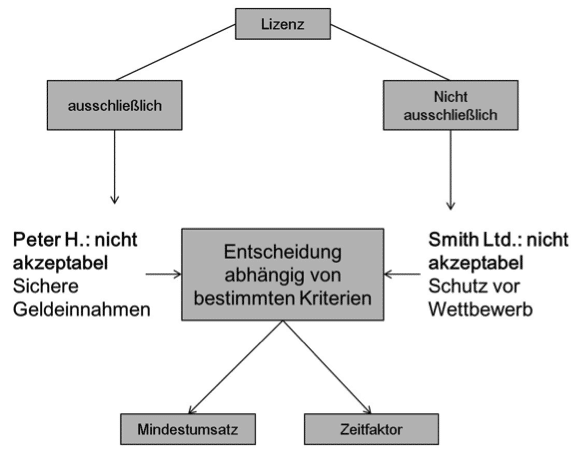Im Rahmen unserer „Miniserie“ über internationale Verhandlungsführung haben wir im letzten Artikel die Ziele der Verhandlung sowie eine effektive Vorbereitung und Argumentation besprochen. Heute geht es um weitere wesentliche Aspekte der internationalen Verhandlungsführung anhand eines Fallbeispiels.
Peter H. verhandelt heute mit Vertretern des australischen Unternehmens Smith Ltd., einem Wettbewerber aus dem Bereich Keilriemen. Smith Ltd. möchte seine Produktqualität verbessern und verhandelt mit Peter H. über eine Know-how-Lizenz. Da es sich für das Unternehmen von Peter H. aus verschiedenen Gründen nicht lohnt, selbst in Australien zu produzieren, ist auch er an der Vergabe einer Herstellungslizenz interessiert.
Smith Ltd. strebt eine ausschließliche Herstellungslizenz für Australien an. Sie müssen zur Umsetzung des Know-hows viel investieren und wollen daher in Australien geschützt sein. Peter H. geht es um einen gesicherten Ertrag aus Lizenzgebühren. Er befürchtet, Geld zu verlieren, denn falls die Smith Ltd. das Know-how nicht wie vorgesehen umsetzen kann, bleiben seine Lizenzeinnahmen, die an den Umsatz von Smith Ltd. gekoppelt sind, gering. Peter H. beabsichtigt eine Lizenz ohne Ausschließlichkeit zu vergeben, um ggf. einem weiteren Unternehmen eine Lizenz verkaufen zu können.
Ein Scheitern scheint vorprogrammiert. Beide Parteien beharren auf ihren Positionen und die Verhandlungsatmosphäre verschlechtert sich. Das Problem reduziert sich auf die Position, ob die Herstellungslizenz ausschließlich oder nicht ausschließlich sein soll. Auch wenn sich die Parteien über die anderen Themen einig sind, wird die Lizenz zur Kernfrage. Eine positionsorientierte Verhandlungsweise führt nicht nur zur Uneinigkeit in der Sache, sondern auch zu einer Vermischung von Sach- und Beziehungsebene.
Wie kann dieses Problem gelöst werden? Peter H. muss versuchen, sachlich und interessensorientiert zu verhandeln. Zunächst sollte die ungeklärte Frage der „Lizenz“ zum gemeinsamen Problem von beiden Parteien erklärt werden. Des Weiteren sollte eine Struktur entwickelt werden, die aufzeigt, wo Interessen und gemeinsame Schnittpunkte liegen. Sie ist im Idealfall von einer der Parteien bereits vorab entwickelt worden und könnte wie in der nachfolgenden Abbildung aussehen:

Bei einer genaueren Analyse dieser Strukturen erkennt man, dass sich die Interessen beider Parteien an einem bestimmten Punkt überschneiden: Peter H. vergibt Smith Ltd. eine ausschließliche Lizenz mit der Maßgabe, dass nach einer festgelegten Anlaufzeit ein gewisser Mindestumsatz pro Jahr erzielt wird. Damit ist eine Mindestlizenzgebühr gesichert. Solange Smith Ltd. diesen Mindestumsatz erzielt, der sich im Laufe der Jahre auch staffeln kann, darf die Lizenz nicht an Dritte in Australien vergeben werden. Die Ausschließlichkeit koppelt sich also an einen Mindestumsatz – die Lizenz ist somit quasi ausschließlich und die Smith Ltd. bleibt in ihrem Land konkurrenzlos.
In der Regel gewähren beide Parteien einander im Verlauf der Gespräche Konzessionen und nähern sich in ihren Standpunkten an. Man sollte dabei auch bei der einzelnen Konzession verhandeln. Ein kluger Verhandlungspartner gibt eine Konzession möglichst nur dann ab, wenn die andere Partei als Gegenleistung zu einem Zugeständnis bereit ist. Die Möglichkeiten, Konzessionen zu machen, werden desto größer, je besser man die eigenen und die Interessen der anderen Seite kennt.
Relevante Aspekte beim internationalen Verhandeln:
Kommunikationslevel
Analysieren Sie das Sprachverständnis der anderen Seite, d. h. wie tiefgehend und detailliert ist ihre Sprachkenntnis und wie stark sind die Überschneidungen zwischen dem was Sie sagen und was die andere Seite entgegnet. Je treffender Ihre Analyse ausfällt, desto besser können Sie einschätzen, ob die Aussagen beider Parteien deckungsgleich sind.
Aktives Zuhören und Fragen
Die Interessen müssen durch interessiertes Zuhören und Nachfragen erforscht werden. Die Fähigkeit des Zuhörens ist ein Trumpf im Zeitalter der Internationalisierung! Wer den Verhandlungspartner ausreden lässt, sich in ihn hineinversetzt, gezielt nachfragt und von Belehrungen absieht, hat gute Chancen, ein möglichst umfangreiches Bild von der anderen Seite zu erhalten. Denn Zuhören und Verstehen heißt noch lange nicht, mit einer spezifischen Meinung einverstanden zu sein. Daneben bekommt man die Möglichkeit, Widersprüche, die allein auf dem Vortrag der anderen Partei basieren, aufzudecken. Dann schlägt man sie mit ihren eigenen Waffen, d. h. mit ihren eigenen Argumenten.
Definition von Schlüsselbegriffen
Bei vielen Verhandlungen bietet es sich an, Schlüsselbegriffe des Geschäfts vorab gemeinsam zu definieren. So werden Missverständnisse von Anfang an reduziert und der Verhandlungsverlauf strukturiert.
Interessen statt Positionen
Positionen sind häufig mit negativen Festlegungen verbunden und spiegeln persönliche Einstellungen wider. Es ist schwierig, sich von einem solchen Standpunkt zu lösen, ohne zumindest teilweise das Gesicht zu verlieren. Besser ist es, die hinter den offensichtlichen Positionen versteckten Interessen zu erforschen und diese zu besprechen.
Die interessenorientierte Verhandlung wirkt deeskalierend und zeigt auf, wie man die zugrunde liegenden Vorstellungen beider Parteien erkennt und mögliche Schnittpunkte findet.
Kennt man die Interessen, ist es eher möglich, angemessen und wirkungsvoll darauf zu reagieren. Wem es gelingt, die Position der Gegenpartei erfolgreich zusammenzufassen und dann seinen eigenen Standpunkt zu erläutern, der verbessert seine Erfolgschancen wesentlich.
Erweiterung der Verhandlungsmaterie
Wenn man sowohl die eigenen als auch die Interessen der Gegenseite erforscht hat, ergeben sich neue, bisher nicht erkannte Möglichkeiten einer Lösung – die Verhandlungsmaterie ist somit erweitert.
Vertragskoordinator
Häufig hilft es, einen Vertragskoordinator auf beiden Seiten zu ernennen. Wenn eine derartige Vorgehensweise bei Ihrem Geschäftspartner bisher unüblich war, sollten Sie ihm die Vorzüge einer funktionierenden Arbeitsebene klarmachen. Betonen Sie unter Beachtung aller interkulturellen Gegebenheiten auch seine Mitwirkungspflichten, um erforderliche Vorarbeiten für die Vertragsverhandlung zu gewährleisten. Schlagen Sie das weitere Vorgehen vor und erarbeiten Sie gemeinsam mit Ihrem Partner die einzelnen Implementierungsschritte bzw. Meilensteine: Wer? Wann? Mit wem? Auf welche Weise? Legen Sie auch fest, wer für die Einhaltung der Meilensteine verantwortlich ist. So stellen Sie sicher, dass die Euphorie nach einem gemeinsam erzielten Verhandlungsergebnis nicht verpufft, sondern das weitere Vorgehen mithilfe eines Vertragskoordinators effizient, schnell und zielgerichtet voranschreitet.
Zum letzten Artikel Spielregeln für eine internationale Verhandlungsführung (Teil 1)
Zum letzten Artikel Spielregeln für eine internationale Verhandlungsführung (Teil 3)




